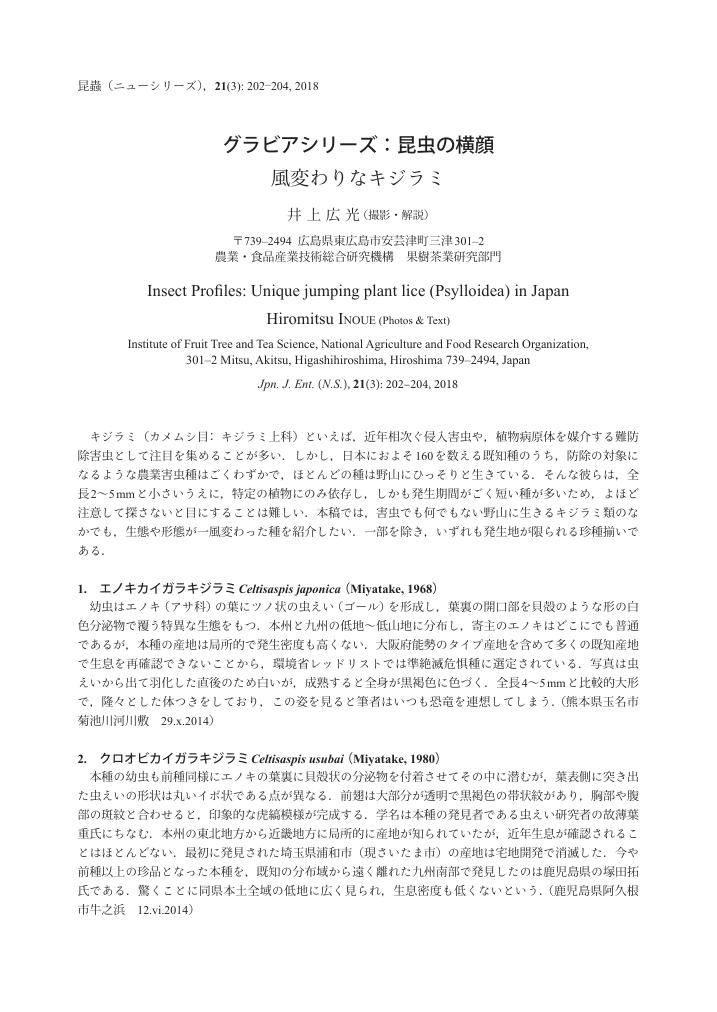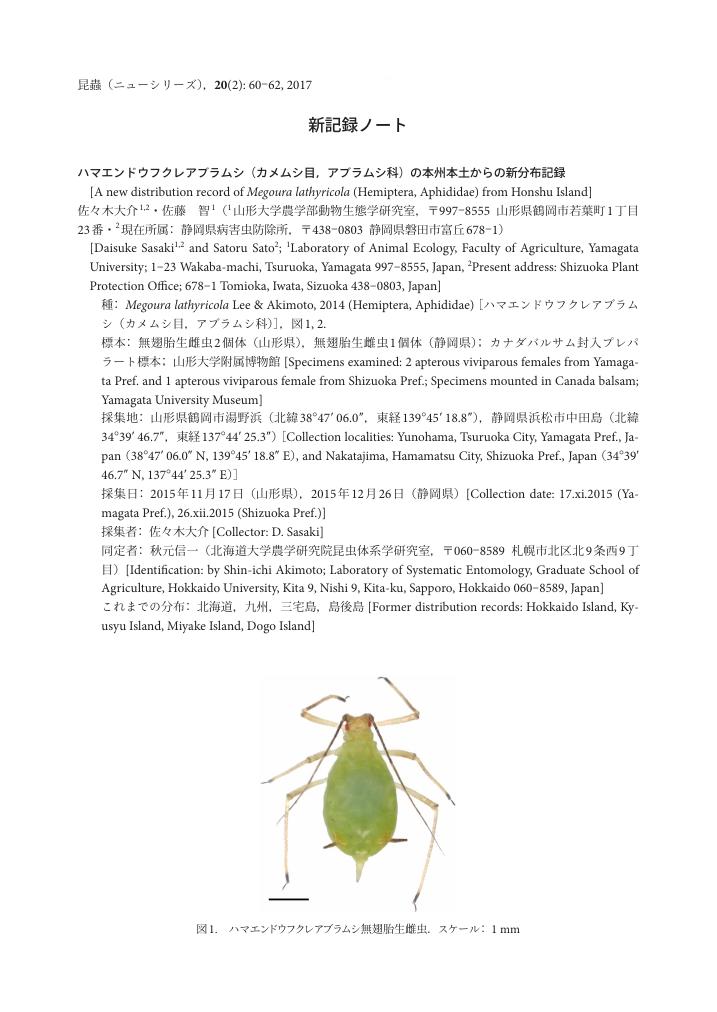1 0 0 0 OA 石井象二郎先生を偲ぶ
- 著者
- 市川 俊英
- 出版者
- 一般社団法人 日本昆虫学会
- 雑誌
- 昆蟲.ニューシリーズ (ISSN:13438794)
- 巻号頁・発行日
- vol.8, no.1, pp.25-26, 2005-03-25 (Released:2018-09-21)
1 0 0 0 岡田豊日先生を偲ぶ
- 著者
- 鈴木 邦雄
- 出版者
- 日本昆虫学会
- 雑誌
- 昆蟲.ニューシリーズ (ISSN:13438794)
- 巻号頁・発行日
- vol.3, no.1, pp.27-29, 2000
1 0 0 0 多様なクモ網を打破したクモヒメバチの多彩な産卵行動戦術
- 著者
- 髙須賀 圭三
- 出版者
- 一般社団法人 日本昆虫学会
- 雑誌
- 昆蟲.ニューシリーズ (ISSN:13438794)
- 巻号頁・発行日
- vol.22, no.1, pp.11-23, 2019
<p>クモの飼い殺し外部寄生というユニークな生態を獲得したクモヒメバチのクモに対する特異的な攻撃的産卵行動を概説した.いずれの種も,それぞれの寄主クモが作る網型に極めて特化した適応的行動(戦術)を有することが報告されている.クモヒメバチ全体で見ると非常に多彩な戦術が進化しているが,いずれもクモに気づかれないように(能動的接近型,突入型,待ち伏せ型),あるいは敵として認識されないように(攻撃的擬態型)行動しており,クモを狩る有剣類に見られるようなクモを追い立てて追跡するという戦術は知られていない.</p>
1 0 0 0 OA 日本産双翅目ノート2
- 著者
- 笹川 滿廣
- 出版者
- 一般社団法人 日本昆虫学会
- 雑誌
- 昆蟲.ニューシリーズ (ISSN:13438794)
- 巻号頁・発行日
- vol.6, no.3, pp.119-133, 2003-09-25 (Released:2018-09-21)
- 参考文献数
- 35
Japanese species of the Mycetophilidae and Sciaridae were reviewed. Ten Palaearctic species of the mycetophilid gnats, Mycomya matilei, M. simulans and M. neodentata, Sciophila dziedzickii and S. interrupta, Leia alternans and L. bilineata, Exechia dorsalis, Trichonta vittata and Phronia willistoni, and eight Palaearctic species of the sciarid gnats, Bradysia subbetuleti and B. brachystyla, Ctenosciara nudata, Phytosciara flavipes, P. ninae and P. ussuriensis, and Sciara humeralis and S. lackschewitzi, were recorded from Japan for the first time. Larval host fungi for the mycetophilid gnats were given. A replacement name, subgenus Merizomma nom. Nov., for the subgenus Chorizomma Sasakawa, 1997, of the genus Lycoriella Frey (Sciaridae) was proposed, because Chorizomma was preoccupied as an arachnid genus name by Simon, 1872.
1 0 0 0 OA エダヒゲネジレバネの生態に関する研究
- 著者
- 前田 泰生 町田 禎之 北村 憲二
- 出版者
- 一般社団法人 日本昆虫学会
- 雑誌
- 昆蟲.ニューシリーズ (ISSN:13438794)
- 巻号頁・発行日
- vol.10, no.2, pp.33-46, 2007-06-25 (Released:2018-09-21)
- 参考文献数
- 44
Biology of Elenchus japonicus (Esaki et Hashimoto) was studied by rearing host delphacid planthoppers, Sogatella furcifera (Horvath) in 2 types of vials (Diameter: 20mm; Length: 10 and 18cm) in 1985. The 1st instar larvae of E. japonicus mostly preferred the 2nd to 5th instar larvae of S. furcifera as hosts. The duration of emergence of the 1st instar larvae from the maternal body continued for 12 hours, and these larvae survived up to 15hrs. The 1st instar larvae gnawed with their mandibles the inter-segments between either ventral or dorsal terga to invade the host's body, but position of the inter-segments used was not fixed. The development of immatures in host bodies differed slightly, depending on the host stages into which the 1st instar larvae invaded. The larval development reared at 28℃ was the fastest in the 5th instar larvae of hosts, spending 10 days from invasion of the 1st instar larva to extrusion of the last larva in female stylopids, and for 13 days from invasion of the 1st instar larva to emergence of adults in male stylopids. Both sexes of most stylopids extruded their cephalothoraces at definite positions between the 7th and 8th terga of either side of the pleural membrane of adult hosts, irrespective of their sexes, when they had parasitized singly. However, other stylopids, except for the individual which extruded at a definite position, could extrude at aberrant positions, when they superparasitized. The number of stylopids parasitized/host averaged 1.2 and up to 4 maximum. Sex ratio was slightly male-biased (0.62, 179/288). The mean value of the egg complement of female stylopids that parasitized singly female hosts was 1,237±194 (N=19). However, the values were variable, depending on the host species, sex of hosts, number of stylopids per host, and host generation, reflecting that the size of female stylopids was presumably affected by these factors.
1 0 0 0 OA 風変わりなキジラミ
- 著者
- 井上 広光
- 出版者
- 一般社団法人 日本昆虫学会
- 雑誌
- 昆蟲.ニューシリーズ (ISSN:13438794)
- 巻号頁・発行日
- vol.21, no.3, pp.202-204, 2018-09-25 (Released:2019-10-10)
- 著者
- 大原 昌宏
- 出版者
- 日本昆虫学会
- 雑誌
- 昆蟲.ニューシリーズ (ISSN:13438794)
- 巻号頁・発行日
- vol.13, no.2, pp.83-92, 2010
- 被引用文献数
- 1
The Hokkaido University Museum has promoted general education for taxonomy, that is, training courses for parataxonomists in Japan and Indonesia. During last six years, we conducted a total of 99 courses and the total number of participants has reached 1,271. In this paper I show (1) a chronological history of parataxonomists courses in Japan and Asia, and (2) the present situation of the courses, and also consider (3) a functional aspect of the parataxonomists courses for educating undergraduate and graduate students and citizens as candidate researchers in taxonomy, (4) effects of the courses on the public recognition of the taxonomy and biodiversity in Japan, and (5) promise of the courses.
- 著者
- 長澤 淳彦 昆野 安彦 松田 一寛
- 出版者
- 一般社団法人 日本昆虫学会
- 雑誌
- 昆蟲.ニューシリーズ (ISSN:13438794)
- 巻号頁・発行日
- vol.6, no.3, pp.117-118, 2003-09-25 (Released:2018-09-21)
- 参考文献数
- 5
Cassida nebulosa L. and C. piperata Hope are common leaf beetles found on the leaves of chenopodiaceous plants in Japan. From the pupae of the two leaf beetles, we found a hymenopterous parasitoid, Holcotetrastichus rhosaces (Walker), which has not been recorded from Japan.
1 0 0 0 OA 証拠標本の保存の重要性 : あなたが発表した論文の内容が後世で無視されないために
- 著者
- 広瀬 義躬
- 出版者
- 一般社団法人 日本昆虫学会
- 雑誌
- 昆蟲.ニューシリーズ (ISSN:13438794)
- 巻号頁・発行日
- vol.15, no.1, pp.28-31, 2012-01-05 (Released:2018-09-21)
1 0 0 0 OA シイタケの害虫としてのムラサキアツバ(鱗翅目: ヤガ科)
- 著者
- 吉松 慎一 仲田 幸樹
- 出版者
- 一般社団法人 日本昆虫学会
- 雑誌
- 昆蟲.ニューシリーズ (ISSN:13438794)
- 巻号頁・発行日
- vol.6, no.2, pp.101-102, 2003-06-25 (Released:2018-09-21)
- 参考文献数
- 3
We observed that a fungivorous moth, Diomea cremata damaged the shiitake mushroom, Lentinula edodes (Berk.) Pegler cultivated on synthetic logs (mainly composed of sawdust), which have replaced the use of natural logs over the last decade. It is considered that D. cremata has become a new pest of this fungus. The larvae appear to consume the thick brown mycelial coat formed on the surface of synthetic logs rather than the fresh fruit body.
- 著者
- 杉浦 真治 深澤 遊 山崎 一夫
- 出版者
- 日本昆虫学会
- 雑誌
- 昆蟲.ニューシリーズ (ISSN:13438794)
- 巻号頁・発行日
- vol.5, no.4, pp.143-144, 2002
- 参考文献数
- 6
Platurocypta punctum (Stannius) (Diptera: Mycetophilidae) was firstly recorded from Japan based on the adult specimens emerged from a fruiting body of Fuligo septica (L.) (Myxomycetes: Physarales: Physaraceae). We observed the larvae feeding on spores within the fruiting body at Kamigamo Experimental Forest in Kyoto, central Japan. P. punctum may be closely associated with slime molds.
1 0 0 0 OA ヒラズゲンセイの配偶システムの観察と生活史ノート
- 著者
- 岡本 素治
- 出版者
- 一般社団法人 日本昆虫学会
- 雑誌
- 昆蟲.ニューシリーズ (ISSN:13438794)
- 巻号頁・発行日
- vol.14, no.4, pp.263-275, 2011-10-05 (Released:2018-09-21)
ヒラズゲンセイの配偶システムについて,羽化脱出直後からの行動観察に基づいて概要を明らかにし,あわせて生活史に関して得られた知見を報告し考察した.ヒラズゲンセイはキムネクマバチに寄生し,成虫は,長い擬蛹期と蛹期を経て,近畿地方では5月の末から6月の中旬に出現する.羽化してクマバチ巣から出ると,雄は特徴的な姿勢をとり,恐らくフェロモンを放出して雌を呼ぶ(コーリング行動).雌は,羽化脱出してしばらくすると飛び立ち,雄のいる巣を探索する.数10m離れた遠方から匂いを頼りに雄の周辺に飛来するのは容易なようであるが,そこから雄がいる巣の場所に到達するには時間がかかる.特に,雄がコーリング行動を止めると,雄のそばに到達するのに要する時間は著しく増大する.雌が雄のそばに至ると交尾が行われるが,通常のマウンティングに先立ち,雄が雌の上に逆向きに重なる特異な行動パターン(「逆マウント」と名付けた)が見られた.交尾がすむと,雌は産卵のためにクマバチ巣内に侵入しようとするが,クマバチによるさまざまなレベルの抵抗を受ける.侵入・産卵に成功した雌は,巣坑内で卵を防御する位置にとどまる.雄も雌に続いて巣坑内に侵入するが,その後も午前中は巣坑外に出てコーリングを行う.2週間程度で孵化した1齢幼虫は,クマバチの毛に大腮でしがみつき,分散していく.トウネズミモチの花の雄蘂の上で訪花活動を行うクマバチを待つヒラズゲンセイの1齢幼虫を発見し報告した.
1 0 0 0 OA ハマエンドウフクレアブラムシ(カメムシ目,アブラムシ科)の本州本土からの新分布記録
- 著者
- 佐々木 大介 佐藤 智
- 出版者
- 一般社団法人 日本昆虫学会
- 雑誌
- 昆蟲.ニューシリーズ (ISSN:13438794)
- 巻号頁・発行日
- vol.20, no.2, pp.60-62, 2017-04-05 (Released:2019-04-05)
- 参考文献数
- 9
1 0 0 0 OA エサキアメンボの腹面色彩と生殖休眠に及ぼす光周期の影響
- 著者
- 増田 倫士郎 中尾 史郎
- 出版者
- 日本昆虫学会
- 雑誌
- 昆蟲.ニューシリーズ (ISSN:13438794)
- 巻号頁・発行日
- vol.16, no.3, pp.147-158, 2013-07-05 (Released:2018-09-21)
エサキアメンボの腹面色彩には黒色型と白色型の季節型が知られる.本研究では和歌山県紀の川市個体群を様々な光周条件下で飼育し,腹面黒化と生殖休眠誘導の関係を把握した.さらに野外での季節消長を調査して黒色型と休眠個体の出現時期を解明した.短日条件下で発育した雌には休眠が誘導され,その臨界日長は約13.75時間だった.明期14時間以下の短日条件で発育したすべての個体は黒色型となったが,明期14.5時間以上の長日条件で発育した大部分の個体は白色型となった.黒色型の雌には休眠虫と非休眠虫が出現したが,休眠虫は白色型には出現しなかった.幼虫後期(4齢と5齢幼虫)の光周条件が休眠誘導と色彩型決定に重要であった.野外において本種は年3回発生し,黒色型の休眠雌は9月上旬から出現することが示唆された.第1世代成虫は5月中下旬に出現し,それらはすべて白色型で,休眠せず産卵を開始するだろう.本研究結果は,黒色型の発現が休眠誘導と厳密に同調しないものの,越冬と密接に関連することを示唆した.
- 著者
- 屈 達才 前田 泰生 郷原 匡史 中塚 硬三 北村 憲二
- 出版者
- 日本昆虫学会
- 雑誌
- 昆蟲.ニューシリーズ (ISSN:13438794)
- 巻号頁・発行日
- vol.5, no.4, pp.121-141, 2002
- 参考文献数
- 42
- 被引用文献数
- 1
Three species of astigmatid mites which infest mason bees, i.e., Chaetodactylus hirashimai, C. nipponicus and Tortonia sp., are known to occur in Japan. Two of them, C. nipponicus and T. sp. are sympatrically distributed in central and northern Japan. They are cleptoparasites of Osmia cornifrons, which is utilized as a pollinator of apples. The invasion/infestation patterns of these mites were studied through a survey conducted at 24 apple orchards in various localities during winter between 1999 and 2001. A population of O. cornifrons was reared in Sendai City, northern Japan, in spring of 1999 so as to analyse the synchronization between invasion/infestation of mites and nesting activity of host bees. As overwintering stages of C. nipponicus, phoretic and cyst-like deutonymphs were found together in the same cells, while 5 stages (larvae, protonymphs, tritonymphs, adults and phoretic deutonymph) were confirmed to hibernate in Tortonia sp. The cyst-like deutonymphs were absent in the latter species. In C. nipponicus, the percentage of phoretic deutonymphs was extremely high (up to 99.6% per host cell), while in T. sp. was lower (6.6% in total). The life type of these 2 mite species is regarded as phoretic- and dweller-like, respectively. The difference of their life types between 2 mite species are enable the partitive use of the pollen-mass stored in the same nests. The following features, regarding to the invasion/infestation patterns, were recognized. 1) Mostly, the first nests made in tubes were infested by both species of mites. The number of cells infested by C. nipponicus extended up to 9 cells, but usually the inner ones were apt to be infested. On the other hand, infested cells were found throughout nest tubes in T. sp.; 2) Distribution and numbers of dead cell contents in a nest by infestation of mites differed between 2 mite species. Only 1-3 cell contents were killed in C. nipponicus, and none killed in T. sp.; 3) Prior to feed on the stored pollen-mass, both species of mites killed hosts. However, they were able to kill hosts of which stages were from egg to early third instar larva. To kill host eggs, it was needed more than 50 adult mites. Those hosts that escaped from slaughter survived and formed normal cocoons; 4) Coinhabiting with C. nipponicus and T. sp. in the same host cell was less frequently occurred (7.1% in total). In these cells, the individual ratio of C. nipponicus was always higher than that of T. sp. The 5 overwintering stages, except phoretic deutonymph, in Tortonia sp. were not all in diapause. These stages began to develop into the next stages sooner, when new food was given under warm temperature. The phoretic deutonymphs of both mite species activated their development by clinging to host bee bodies in both mite species. The cyst-like deutonymphs of C. nipponicus developed into the tritonymphs when subjected them to the scent of host bees.
- 著者
- 細谷 忠嗣 神保 宇嗣
- 出版者
- 日本昆虫学会
- 雑誌
- 昆蟲.ニューシリーズ (ISSN:13438794)
- 巻号頁・発行日
- vol.13, no.2, pp.48-57, 2010
2010年は国際生物多様性年であり,10月には名古屋で生物多様性条約第10回締約国会議(CBD COP10)が開催される.現在,人間活動によって生じた地球温暖化などの環境変化や開発による生態系の破壊,密猟や乱獲などによる生物多様性の急速な喪失が,生物多様性の危機として大きな問題となっており,「2010年目標」の評価や「ポスト2010年目標」の策定,遺伝資源へのアクセスと利益配分(ABS)など本会議には大きな関心が集まっている.この会議に向けて,日本でも日本生物多様性観測ネットワーク(J-BON)や東・東南アジア生物多様性情報イニシアティブ(ESABII)などの関連する大きなプロジェクトが立ち上げられている.分類学には,これらの生物多様性条約に関わるプロジェクトへの貢献が期待されている.こうした問題解決への参画は,分類学への関心を高め,その地位を向上させるだけでなく,新しい研究分野開拓という形で学問自体の進展にもつながるであろう.本特集では,生物多様性条約関連プロジェクトに参画している研究者がその概要と分類学者との関係のあり方を紹介していくことで,分類学者として生物多様性条約とその関連活動にどのように向き合い,そして参加していくべきかを考えていく.



